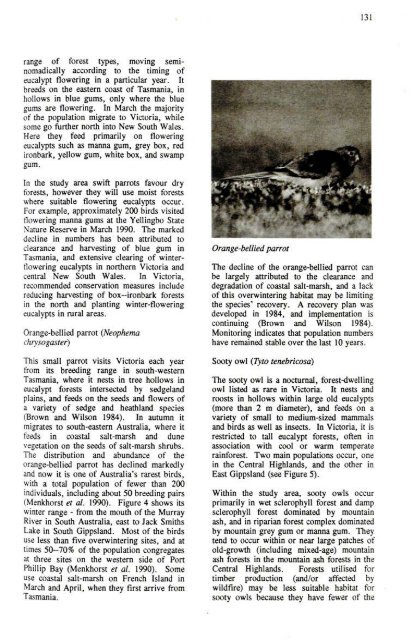Factors Affecting Flora Conservation - Victorian Environmental ...
Factors Affecting Flora Conservation - Victorian Environmental ...
Factors Affecting Flora Conservation - Victorian Environmental ...
You also want an ePaper? Increase the reach of your titles
YUMPU automatically turns print PDFs into web optimized ePapers that Google loves.
131<br />
range of forest types, moving seminomadically<br />
according to the timing of<br />
eucalypt flowering in a particular year. It<br />
breeds on the eastem coast of Tasmania, in<br />
hollows in blue gums, only where the blue<br />
gums are flowering. In March the majority<br />
of the population migrate to Vicloria, while<br />
some go ftirther north into New South Wales.<br />
Here they feed primarily on flowering<br />
eucalypts such as manna gum, grey box, red<br />
ironbark, yellow gum, white box, and swamp<br />
gum.<br />
In the study area swift parrots favour dry<br />
forests, however they will use moist forests<br />
where suitable flowering eucalypts occur.<br />
For example, approximately 200 birds visited<br />
flowering manna gums at the YeUingbo Stale<br />
Namre Reserve in March 1990. The marked<br />
decline in numbers has been attributed to<br />
clearance and harvesting of blue gum in<br />
Tasmania, and extensive clearing of winterflowering<br />
eucalypts in northern Victoria and<br />
central New South Wales. In Victoria,<br />
recommended conservation measures include<br />
reducing harvesting of box-ironbark forests<br />
in the north and planting winter-flowering<br />
eucalypts in mral areas.<br />
Orange-bellied parrot {Neophema<br />
chrysogaster)<br />
This small parrot visits Victoria each year<br />
from its breeding range in south-western<br />
Tasmania, where it nests in tree hollows in<br />
eucalypt forests intersected by sedgeland<br />
plains, and feeds on the seeds and flowers of<br />
a variety of sedge and heathland species<br />
(Brown and Wilson 1984). In autumn it<br />
migrates to south-eastern Australia, where il<br />
feeds in coastal salt-marsh and dune<br />
vegetation on the seeds of salt-marsh shmbs.<br />
The distribution and abundance of the<br />
orange-bellied parrot has declined markedly<br />
and now it is one of Australia's rarest birds,<br />
widi a total population of fewer than 200<br />
individuals, including about 50 breeding pairs<br />
(Menkhorst et al. 1990). Figure 4 shows its<br />
winter range - from the mouth of the Murray<br />
River in Soudi Australia, east to Jack Smiths<br />
Lake in South Gippsland. Most of the birds<br />
use less than five overwintering sites, and at<br />
times 50-70% of the population congregates<br />
at three sites on the westem side of Port<br />
Phillip Bay (Menkhorst et al. 1990). Some<br />
use coastal salt-marsh on French Island in<br />
March and April, when they first arrive from<br />
Tasmania.<br />
Orange-bellied parrot<br />
The decline of the orange-beUied parrot can<br />
be largely attributed to the clearance and<br />
degradation of coastal salt-marsh, and a lack<br />
of this overwintering habitat may be limiting<br />
the species' recovery. A recovery plan was<br />
developed in 1984, and implementation is<br />
continuing (Brown and WUson 1984).<br />
Monitoring indicates that population numbers<br />
have remained stable over the last 10 years.<br />
Sooty owl (Tyto tenebricosa)<br />
The sooty owl is a nocturnal, forest-dwelling<br />
owl listed as rare in Victoria. It nests and<br />
roosts in hollows within large old eucalypts<br />
(more than 2 m diameter), and feeds on a<br />
variety of small to medium-sized mammals<br />
and birds as well as insects. In Victoria, it is<br />
restricted to tall eucalypt forests, often in<br />
association with cool or warm temperate<br />
rainforest. Two main populations occur, one<br />
in the Central Highlands, and the other in<br />
East Gippsland (see Figure 5).<br />
Within the study area, sooty owls occur<br />
primarUy in wet sclerophyll forest and damp<br />
sclerophyll forest dominated by mountain<br />
ash, and in riparian forest complex dominated<br />
by mountain grey gum or manna gum. They<br />
tend to occur within or near large patches of<br />
old-growth (including mixed-age) mountain<br />
ash forests in the mountain ash forests in the<br />
Cenfral Highlands. Forests utilised for<br />
timber production (and/or aft'ected by<br />
wildfire) may be less suitable habitat for<br />
sooty owls because they have fewer of the
















